Recent Fire Damage Posts
Toasty and Safe from Fires | SERVPRO of Houston County
1/16/2024 (Permalink)
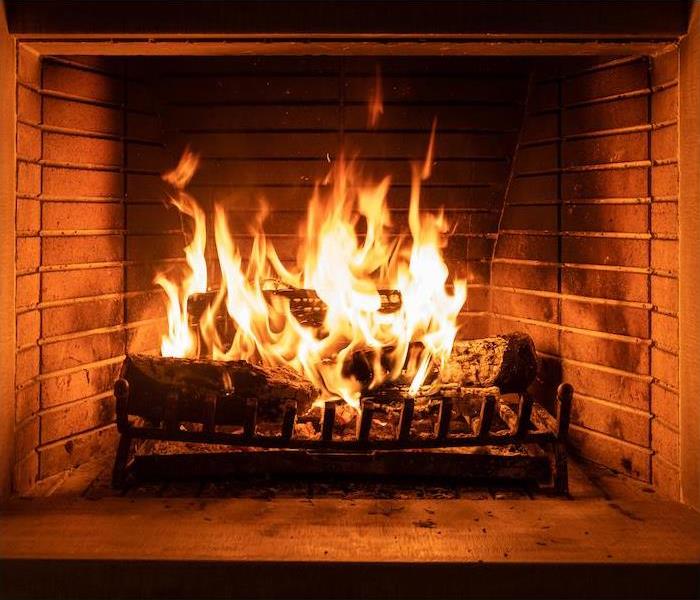 Fire safety is a top priority for us at SERVPRO of Houston County this winter. Keep your home safe with these helpful tips!
Fire safety is a top priority for us at SERVPRO of Houston County this winter. Keep your home safe with these helpful tips!
The cozy season is more than here, which means wearing all the fuzzy clothes and spending as much time as possible under a blanket. There is nothing quite like curling up with a toasty fire gently burning in the fireplace.
Did you know that the number of house fires goes up considerably in the winter? Cozying up is great—when you do it safely. Fireplace, space heaters and other heating devices can leave our homes vulnerable to disasters when they are not handled with care.
Addressing Your FireplaceThere really isn’t anything that can quite compare to the sights and sounds of a fire on a cold night. While it may be a great way to relax, fireplaces are one of the more dangerous places in your home when they are not properly maintained. If you use wood in your fireplace, ash and other debris should be cleaned out after every use. Your chimney should be cleaned and inspected by a professional every year.
Never put anything that could catch fire near your fireplace, including mantle decorations. You should have smoke detectors and a carbon monoxide detector that is working well either in the room with your fireplace or right outside of it. If you have a gas or electric fireplace, check the connection point often to ensure nothing is leaking. Dust around your fireplace weekly, and it’s never a bad idea to keep a fire extinguisher close at hand when you do use your fireplace.
Space Heater SafetySpace heaters are a great way to warm a room, but they are another common source of house fires in the winter. Space heaters are responsible for nearly 1,700 house fires every year, most of them preventable.
Always run your space heater on a flat, even surface. Space heaters need room to work, so make sure they have a three foot radius around them. Always check the cord before plugging it in directly to the wall. Space heaters should never be plugged into an extension cord or power strip.
Teach your children and your pets to stay away from the space heater when it is operating. Even if the heat feels great directly on your feet, avoid putting the space heater too close to the couch, bed or curtains. Turn your space heater off at night—blankets are a much safer option for staying warm.
Suggested Safety Features for Your Space HeaterIf your space heaters are more than five years old, you may want to consider upgrading them in order to get the best safety features. While all new space heaters that are available for purchase are going to come with some kind of safety features, there are a few things you want to look for before you choose to run one in your home.
Do a little research on the manufacturer to ensure they are both certified and reliable. The units should have been put through plenty of testing before being resold. Any space heater you use should have automatic shut off features that kick in when the unit has been running for a certain amount of time and when the unit is bumped or knocked over.
Cords on space heaters should be well-made and at least six feet in length. Since plugging into an extension cord or other electrical extender is a huge no-no with space heaters, make sure you are purchasing one with a long enough cord to meet your needs and run safely.
By giving a little love to your fireplace and running your space heaters safely, you can keep your home warm and toasty all season long. If you do have an incident, one phone call to SERVPRO of Houston County is all it will take to clean up smoke, soot and any other damages fast.
A quick fire damage restoration is just a phone call away. Call SERVPRO® for immediate assistance.
Fire-Free All Holiday Season | SERVPRO of Houston County
11/17/2023 (Permalink)
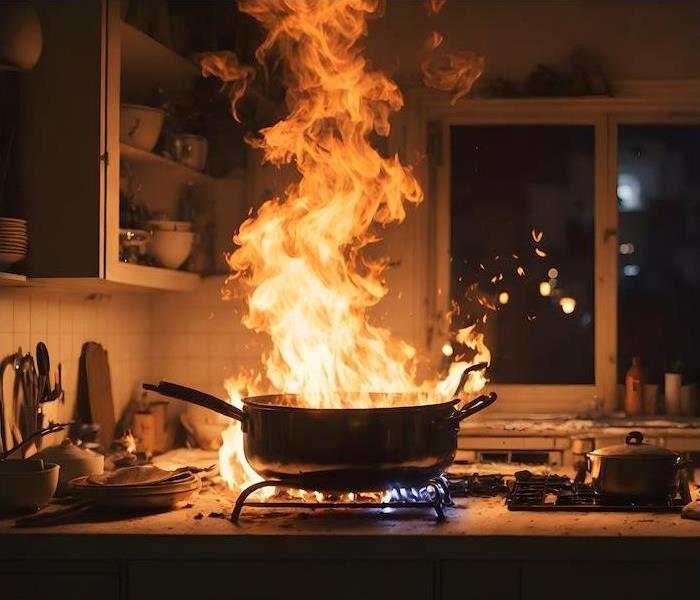 Fire damage in your home? Not for long with SERVPRO of Houston County on the case!
Fire damage in your home? Not for long with SERVPRO of Houston County on the case!
The holiday season has returned, and no matter how you celebrate or when you celebrate, there is bound to be some pretty good food during this time of year. If you are the main chef when it comes to making all the classic family dishes, you’ll need to ensure you are cooking safely to prevent a potential fire.
House fires increase during the holiday season every year, and a good number of them start in the kitchen. That doesn’t mean you should ditch all the old recipes and order a deli platter, instead with a few extra precautions, you can serve the meal you want while enjoying a safe home.
Reducing Flammable Materials in the KitchenWhen you head into the kitchen to start preparing the meal, take a few steps to prepare your space as well. Kitchen fires often move faster because of clutter.
Keep pot holders, wooden cooking utensils, towels and holiday decorations away from any sources of heat. A single oil bubble or a quick spark can catch material on fire and start a spread of flames throughout your kitchen.
Think about what you are wearing as well. Skip the fun apron with the dangling strings and opt for clothes that are slightly tight-fitting without a lot of frills. Loose fabric, hanging decoration and even long sleeves can present a fire hazard while you cook.
Keep a Close Eye on FoodIt is always a good idea to stay close by any time you cook. Whether you are baking, boiling or grilling, a fire can start in a matter of seconds and spread just as fast. Stay in the kitchen so that you can take fast action to put out any flames should they spark.
If you are planning on frying a turkey for one of your celebrations, take a few extra steps to keep everything safe. Make sure the kids and your pets know to stay away while the fryer is on, and follow any safety guidelines laid out by the manufacturer.
Put your fryer on a level surface, and avoid putting too much oil in. Make sure your turkey is completely thawed—even a partially frozen turkey will cause the oil to splatter and pop, creating a burn and fire risk.
Install Protective MeasuresFires may not be totally preventable, but the more you do to stay safe, the lower your risks will be. Make sure your home has plenty of protective measures in place as well.
There should be a smoke detector on every level of your home, including one either in your kitchen or very near it. Get into the habit of checking smoke detector batteries monthly, but also check the one near the kitchen right before your day of cooking for the season.
A small fire extinguisher is another helpful piece of equipment to keep near the kitchen. It should be somewhere you can grab in a hurry, and make sure a few of your family members know how to properly use it. Be sure to keep pot and pan lids at arms’ reach as well so that you can smother any grease fires that might pop up.
Make your home as safe as it is cozy this season. If you do experience a fire of any size, call us. We are available around the clock to handle your damage quickly. We will get your home put back together so that you can get back to enjoying the magic of the season.
House fires can happen in the blink of an eye. Contact us for a quick restoration day or night!
Keeping Bonfires Safe | SERVPRO of Houston County
9/18/2023 (Permalink)
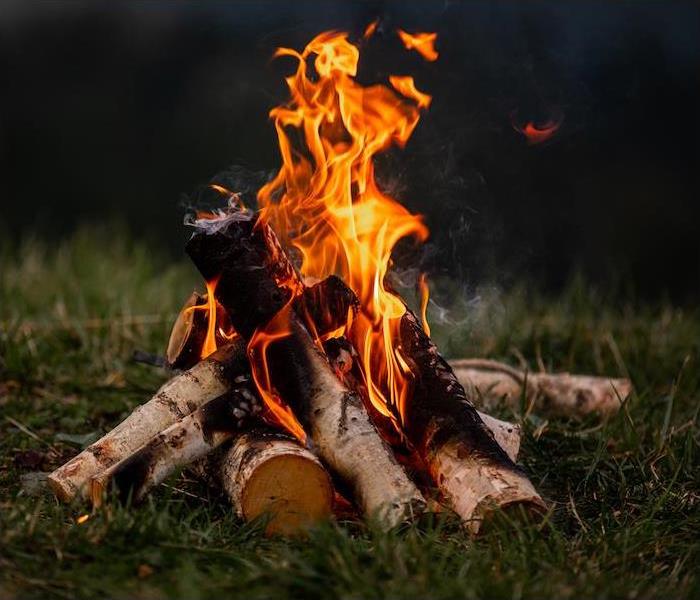 Bonfire season is upon us! SERVPRO of Houston County has your back with these helpful fire safety tips.
Bonfire season is upon us! SERVPRO of Houston County has your back with these helpful fire safety tips.
Which season is your favorite? As we edge ever closer to cooler temps and changing leaves, for many the fall season is one of the best times of year. The humidity breaks and we are finally able to get out the pumpkin decorations while we drink and eat pumpkin-flavored everything.
Fall is also the perfect time for getting outside with the family, gathering around the fire pit to eat too many marshmallows and share plenty of stories. While you melt a little more chocolate, make sure you are also practicing fire safety.
SERVPRO® may have all your restoration needs covered when a disaster strikes, but we also want to help you stay safe and prevent one from ever happening in the first place.
Tips for Starting the FireBefore you actually light your fire, keep a few things you should do in mind:
Do find a location that will be safe to have your fire. It should be in an open space clear of overhangs, loose limbs and a good distance from any structures.
Do keep water nearby. Put a bucket of water close to where your fire will be, or attach a hose that you can turn on quickly. You can also grab a shovel and keep sand or dirt handy to smother out any rouge flames or add to embers when they are still glowing red.
Do take a look at the weather ahead of having your fire. Check the forecast for storms, but also take a look outside and watch for wind. Even a covered fire pit can be dangerous on a windy day. Check for local burn bans the day of your fire so that you can follow county regulations.
Tips for While the Fire Is HotOnce you have gotten your fire safely going, there are a few things you don’t want to do:
Don’t keep your fire going with anything other than treated, approved wood. Lighter fluid and gasoline are dangerous on open flames, and tossing in anything else can cause flames that are higher and hotter than you are prepared for.
Don’t play around the flames. Keep kids, dogs and yard games away from the fire to avoid potential accidents.
Don’t create a bigger fire then you can tend to. It can be easy to build the fire up big enough that you won’t have to tend to it much, but one flame going the wrong way can result in a scorched backyard and put your home at risk.
Don’t ever leave a fire unattended, even when it is just down to red-hot embers. Pour water over it and stick around until it has cooled completely.
Wildfire PreventionUnfortunately, the majority of wildfires are started by human error. If you are going to have a fire outside, it is your duty to not only protect your family and your home, but the environment as well. Use the right materials, don’t make it too big and put it completely out before you leave.
If you do ever have damage from a fire on your property or in your home, call SERVPRO. We are available 24⁄7 to respond to your property and get life put back together fast.
Fire can cause a lot of damage in a short amount of time. Contact us day or night for immediate assistance.
Preventing Fires for a Delightful Summer BBQ Experience | SERVPRO of Houston County
8/10/2023 (Permalink)
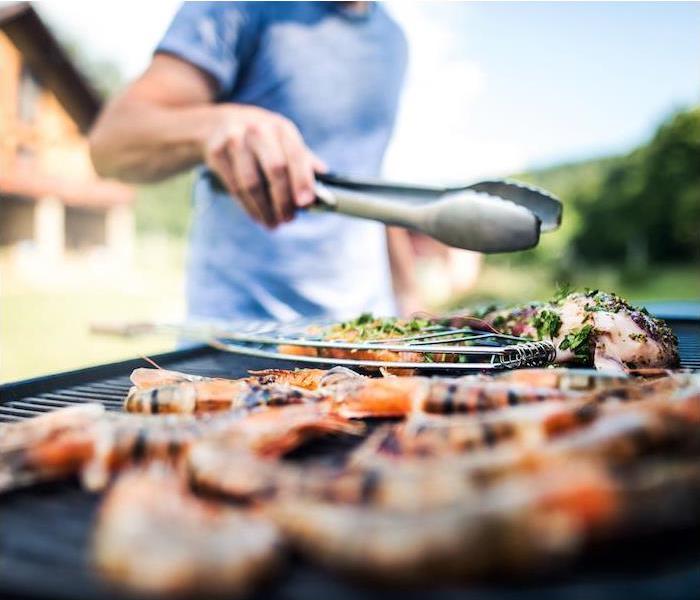 Have you had a barbeque gone wrong? Call SERVPRO of Houston County to get your space back in shape.
Have you had a barbeque gone wrong? Call SERVPRO of Houston County to get your space back in shape.
It’s summertime in Houston County, and locals know the weather can get pretty hot and humid around this time. We’re all relishing the sunny days grilling out by the pool with family and friends.
As you prepare for those backyard BBQs, it’s crucial to prioritize grilling safety to prevent dangerous situations and potential fires. In this blog post, we’ll provide you with tips to ensure a delightful summer BBQ experience without any fire risks.
Finding a Safe Grilling SpaceThe first step in grilling safety is to position your grill in an appropriate location outside, away from enclosed spaces like garages or roof overhangs. Proper ventilation is essential, and any flammable materials above the grill can increase the risk of fire. Make sure to place the grill at least 10 feet away from your house or deck. Make the designated area free from children and pets to ensure everyone’s safety.
Before using a charcoal grill, inspect it for any accumulated ash, dents, or cracks. Propane grill owners should carefully examine the gas lines for leaks and ensure secure connections. Leaking lines or propane tanks can lead to hazardous fire situations.
Stay Alert and Prepared While GrillingWhen grilling, it’s crucial to stay near the grill and have a water source on hand in case you need it. A spray bottle can help control fire flare-ups, and keeping a hose or fire extinguisher within reach is important for emergencies.
After cooking, give the food to someone else to carry into the house and remember to turn off the gas or close the vents for charcoal grills to cut off the oxygen supply. Get rid of ash and embers in a metal can to eliminate potential fire hazards, even after the grilling is complete. Before concluding your BBQ and walking away, ensure that the grill has fully cooled down.
Have a Safe and Enjoyable SummerWe wish you a summer filled with joyful moments and safety. However, in case a fire incident occurs during your BBQ, SERVPRO® of Houston County is ready to assist you with professional fire damage restoration services.
Don’t let fire damage live in your home—contact SERVPRO of Houston County for prompt restoration assistance.
Taking the Fear Out of Fire Safety | SERVPRO of Houston County
6/14/2023 (Permalink)
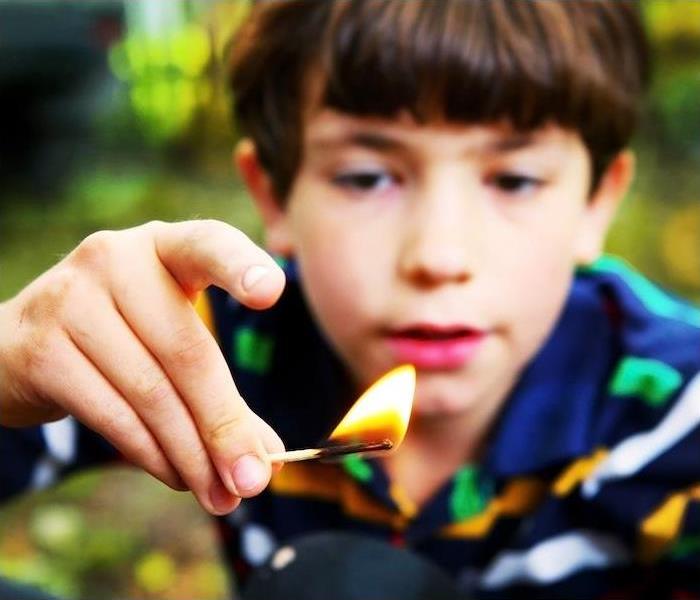 SERVPRO of Houston County is here for you and your family if you experience a fire in your home or business.
SERVPRO of Houston County is here for you and your family if you experience a fire in your home or business.
Parenthood brings incredible rewards, but it is not without its challenges. You bear the responsibility of guiding your children, cultivating their creativity and curiosity and ensuring their safety.
Finding the delicate balance between protecting them and overwhelming them with essential facts can be a tough job!
No matter your age, fire principles can be a life-saving piece of information when a fire emergency breaks out. Do your best to teach your kids about fire safety so they know how to prevent fires and what to do when one happens.
Explain the Dangers of FireChildren grasp concepts better through firsthand experiences, since understanding consequences can be challenging until they witness the actual outcome. But you don’t want to go around starting fires in your home, either!
Have a family conversation about how and where a fire might start and grow, exploring every part of your home that utilizes heat or flames.
You should also ensure that your children understand the intended purpose of matches and lighters and the risks of playing with them. A potential disaster can result from a single match.
Familiarize Them With AuthorityShow your kids photos of police officers and firefighters frequently because they can be frightening when they’re dressed in full gear. Take part in community activities like meet-and-greets that allow them to have fun and interactive encounters with these essential people and know what they look like in action.
Make sure your kids understand that firefighters are dedicated to saving lives when a fire occurs. Teach kids about the importance of firefighters in emergency circumstances and their critical roles.
Kids also need to know what to do when a fire occurs to help the firefighters. Create a sense of excitement by engaging in activities together, such as rehearsing various methods of alerting one another and having race to see who can reach safety the fastest via an army-crawl.
Make a Game Plan TogetherCreating an emergency escape strategy for your home is a crucial step that every family should take, and engaging your children in the process can be both educational and fun! Encourage your kids to explore and identify the fastest way out of each room in your house, and together, draw a diagram to visualize the plan.
Teaching your children how to open a window in case of a fire can be useful information that could save their lives, but it’s important to approach this topic with caution. Show them how to escape through a window, but be sure to emphasize that this should only be done during an emergency.
Designate a secure outdoor meeting area where everyone can gather in the event of a fire. Prioritize practicing your plan regularly, and ensure your children understand the importance of contacting emergency services once they have safely escaped.
Fires can cause widespread damage. Call us for a thorough and efficient restoration.
Clear the Clutter to Prevent Fires | SERVPRO® of Houston County
6/6/2022 (Permalink)
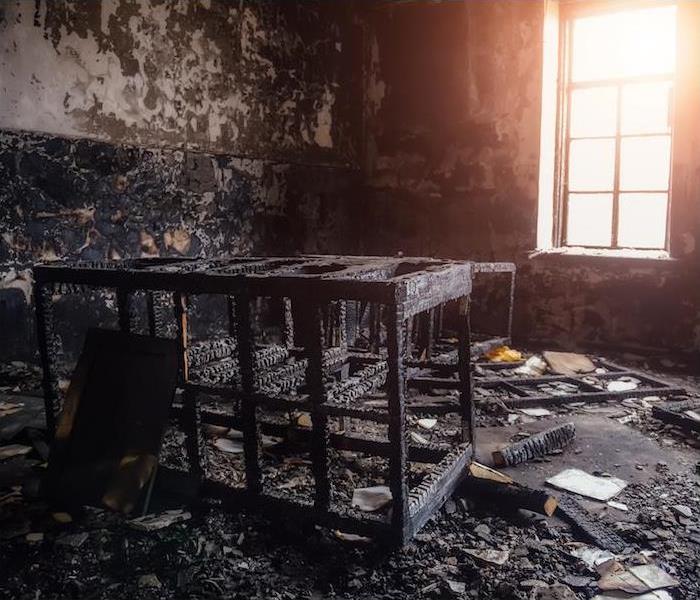 If your home is damaged in a house fire, SERVPRO of Houston County is here to help. Contact us for any fire restoration needs.
If your home is damaged in a house fire, SERVPRO of Houston County is here to help. Contact us for any fire restoration needs.
The American Red Cross has already responded to over 20,000 house fires since the start of 2022. Fires are the most prevalent natural disaster in the United States, claiming thousands of lives each year. Preventing fires will not only save your home, but it can also save your life.
Unplugging appliances, blowing out burning candles and checking your smoke detector on a regular basis are all simple ways to prevent fires within your home. Another simple strategy to prevent fires that you may not have considered is to clean your house thoroughly! Cleaning up around the house can help minimize your risk of a fire.
Clear the ClutterClutter can quickly accumulate in your home, obstructing hallways and staircases. This poses a major fire threat if a fire breaks out, since the clutter could cause the flames to spread quickly.
Keep your house clutter-free by storing any loose clothing or blankets and disposing of trash and boxes. Cleaning up any clothing or blankets around the house could help to keep a fire from spreading. It also makes it easier for you and your family to flee if necessary.
Piled up clothes near a water heater is another frequent cause of house fires. When your water heater heats up, the pile of clothing nearby could catch fire.
Make sure that clothing is not piled up near any equipment that uses heat; this can significantly reduce the danger of fires starting.
Create a Defensible Space in Your YardYou may not realize it because many fires start inside the home, but the cleanliness of your house’s outside is important as well! A well-planned yard layout could keep exterior fires at bay and prevent them from reaching your home.
In the wake of wildfires, California has set regulations for defensible zones, which provide firefighters with room to put out fires and prevent fires from spreading to homes. Even in Houston County, this could be useful in preventing the spread of external fires in your yard.
Defensible space doesn’t mean you can’t plant what you’d like—it simply involves being strategic about the placement of plants near your house.
Cleaning up any litter, dead shrubs and limbs outside your property is another way to keep fires at a distance. They are yet another factor that only serves to strengthen and build a fire.
Keep It Clean & Keep It SafeCleaning your home and yard regularly should be a habit for everyone, not simply to keep it tidy, but also to reduce fire risk! Another method to reduce fire hazards is to thoroughly clean your appliances, such as your oven and refrigerator.
Deep-cleaning the entire house can help prevent fires from spreading and ensure that if you need to evacuate in the event of a fire, there will be a clear path to escape. Keeping your home clutter-free is a simple strategy to avoid disastrous fires from starting while also keeping your home and yard tidy!
Even dusting is an act of defiancé against fire. Dust all surfaces and objects regularly to keep dust and dirt from piling up, and pay particular interest around outlets and appliances.
If you have experienced fire damage or want to learn more about our fire damage restoration services, contact us today. We’re here to act fast, 24⁄7.
Tips to Reduce the Risk of a Commercial Kitchen Fire from your Cooking Systems
12/2/2021 (Permalink)
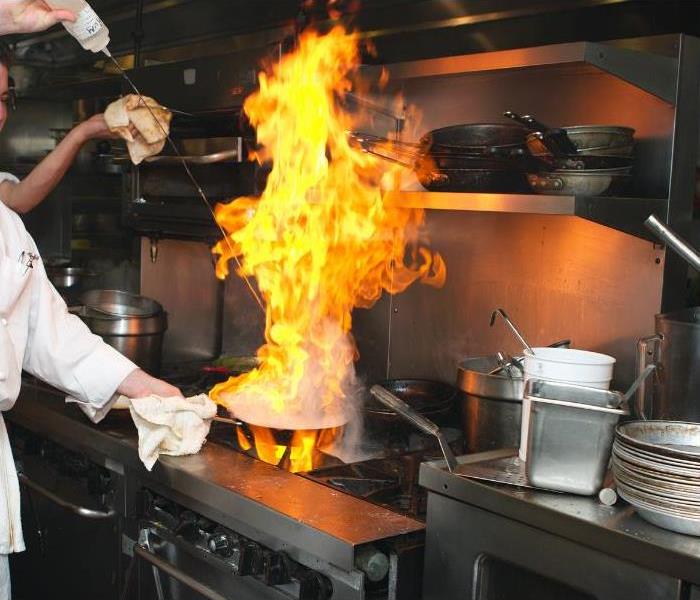 Food in flames while cooking in a commercial kitchen
Food in flames while cooking in a commercial kitchen
Attention all restaurant and bar owners in Warner Robins & Perry: The National Fire Protection Association (NFPA) reports that fire departments responded to over 7,410 structure fires in the kitchen of restaurants and bars in 2017 alone. The majority of these fires were preventable, resulting in three deaths, 110 injuries, and $165 million in property damage annually in commercial kitchens. Not only do kitchen fires threaten the lives of staff and patrons, but they also put restaurants at risk of being shut down due to fire code violations when repairs are needed after a blaze.
What Are My Ducting and Air Movement Requirements to Prevent Fire?
While Chapter 7 of the NFPA 96 Standard for Ventilation Control and Fire Protection of Commercial Cooking Operations covers this extensively, here are a few key items to keep in mind.
First, commercial kitchen ducts should never pass through firewalls, share an exhaust system with the building ventilation, or have obstructed access panels. While doing these things on a commercial kitchen remodel can save costs in the short term, the fire risk increases significantly. If disregarded, your commercial kitchen work will likely not pass inspection.
Make sure to maintain a minimum clearance of 18 inches between combustible materials and the kitchen ducts. This standard is based on Section 4.2 of the NFPA 96, however is one of the easiest to disregard once the kitchen is operational. Ducts can build up high levels of radiant heat that can ignite combustible materials like boxes, cups, plates, utensils, or other kitchen materials.
If you would like additional information on the types of combustible and non-combustible materials that should and shouldn't be kept near the duct, consult Chapter 3 of the NFPA.
What Are My Commercial Kitchen Fire Extinguisher Requirements?
"The NFPA 96 requires automated fire suppression equipment for all grease removal devices, hood exhaust plenums, and exhaust duct systems in a commercial kitchen, as well as any cooking equipment that produces grease-laden vapors." - Koorsen Fire & Security
The NFPA 96 requires use of class K fire extinguishers in conjunction with automatic fire extinguishing systems. These extinguishers also require installed placards stating their extinguisher class. However, in the case of a commercial kitchen fire, it's critical to activate the automatic fire extinguisher system before using portable-type extinguishers. This is because high-efficiency cooking appliances in many modern commercial kitchens are capable of achieving high temperatures that can raise the vegetable oils to intensely high temperatures. When oil ignites at these high temperatures, it can already be so hot that a portable extinguisher is not enough to stop the flames.
Another standard that you should familiarize yourself with is the UL 300 standard.
According to this article by Insureon, a kitchen’s cooking equipment must meet these UL 300 requirements:
- Fire-extinguishing nozzles in the hood, ducts, and above each cooking appliance
- An automatic fuel shut-off capabilities for both gas and electric power sources
- A manual fuel shut-off pull for all power sources
- A wet-chemical fire-extinguishing system that meets UL 300 criteria (one of which is undergoing semiannual checkups by a certified professional)
Practice Proper Maintenance & Inspection in Your Commercial Facility
The first step towards proper maintenance to prevent a commercial kitchen fire in your facility is to create a regular plan for inspections. While you can do these yourself, it is often a good idea to consider outsourcing this service to a proper NICET Certified Fire Inspector. Depending on the volume of cooking in your commercial kitchen, they will likely recommend monthly, quarterly, or annual inspections to ensure compliance and safety.
On regular inspections, fire inspectors will provide the best guidance on where you should focus your team's routine maintenance time and resources. Ultimately, it is up to you as an owner or manager on how closely you implement those recommendations.
Typically, at least the vent, hood, and duct must be cleaned regularly to remove grease vapor and prevent combustible material build-up. Grease Filters should be cleaned at least once per week, and your automatic fire suppression system should be inspected at least every 6 months or as required by your local regulations. Regular cleaning according to equipment specifications should be observed as well.
What To Do If There Is a Fire In My Commercial Kitchen?
If you can, get everyone out safely. If you have an outdoor exit, have people leave that way. Do not open any interior doors or windows or use elevators during a fire. Even if it seems like it’s far away, do not stop to pick up personal belongings. Unless it’s your home, never go back inside during or after a fire. Once you are safe, call 911 immediately and stay on the line until help arrives. Once firefighters arrive on the scene they will assess if there is still a risk for injury within any structure fires before allowing you to re-enter your building.
Next, you should call a fire restoration expert like SERVPRO of Houston County to help you quickly restore your commercial kitchen to an operational state.
Our trained technicians are available 24/7/365, and ready to help. We also offer a special Emergency Response Plan to commercial facilities to reduce property damage in the case of an emergency commercial fire event. Call us today at (478) 224-4148 for emergency services or to schedule your free SERVPRO ERP.
What are the types of fire? Understanding Smoke & Soot
12/2/2021 (Permalink)
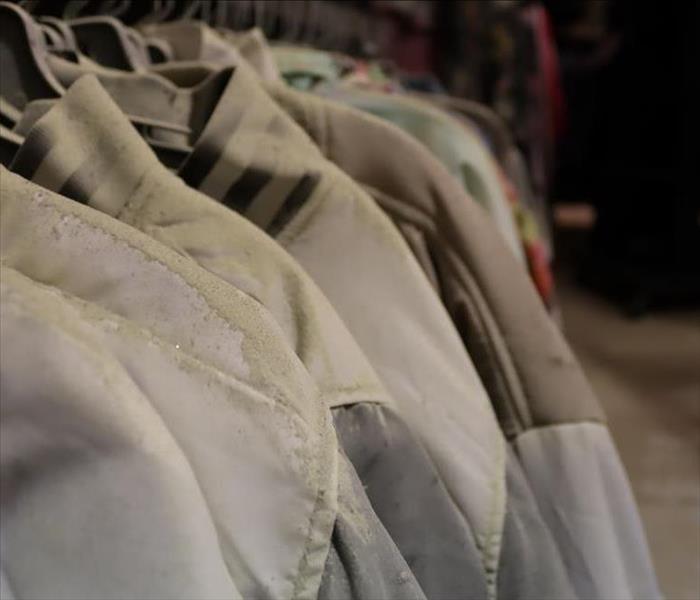 Soot-Covered Clothing after Fire Damage
Soot-Covered Clothing after Fire Damage
How does fire damage your home in Moss Oak or Bonaire? Depending on what kind of materials burn, the short-term and long-term effects of fire can change significantly. After a fire with incomplete combustion, soot is often left over. To get your home back to normal after a fire, you need to remove the soot from surfaces, especially from non-heat resistant surfaces, such as walls and windows, but also from other areas that have been contaminated by smoke or soot.
Knowing what kinds of soot are left over from a fire will help you clean more effectively. This is because protein residues, natural substance residues, and synthetic residues behave and are cleaned differently from each other. Understanding which type is present before a fire restoration will help shed light on the cleaning process to follow.
The Science Behind Smoke & Soot
Smoke and soot particles occur when there is incomplete combustion in a fire. Combustion is a process where fuel, oxygen, and heat combine to rapidly oxidize substances. That oxidization process leaves soot particles. When you burn propane from a gas tank, there is usually enough oxygen around the fire to produce a perfectly clean burn with almost no soot residue. However, if you reduce the amount of oxygen available, more and more soot is left over due to this incomplete combustion. Besides soot particles, volatile organic compounds in the form of gasses are often left over, many of which have been shown to be carcinogenic.
Natural Substance Soot & Smoke
Natural Substance Residues are usually left over when paper or wood is burned. This kind of residue tends to be grey to black and has a dry, powder-like texture. This type of residue, when pure, tends to be quick to clean with vacuums and a combination of wet and dry cleaning techniques. These are usually the easiest kinds of soot residues to clean when compared to the other 2 main types of soot particles after a fire.
Synthetic Soot & Smoke
This kind of soot residue, sometimes described as oily soot or oily smoke, produces a thick, heavy black substance that tends to smear when touched. In some cases, it can even appear almost like a black spider web. When left undisturbed on a surface, it can sometimes be vacuumed away, but if touched, it will tend to smudge and become more difficult to clean. Plastics, and synthetic materials are the usual culprits for this kind of soot residue.
Protein Soot & Smoke
Protein residue occurs when meat, fish, beans, or other protein-containing substances are overcooked or burned. This kind of soot appears yellow to brown, and feels greasy and sticky. Water-based cleaning solutions work well with this kind of soot as long as the surface it is on can be wet cleaned.
How Do You Clean After a Fire?
Smoke and soot can cause secondary damage to materials when left there for long, and improper cleaning methods can cause more damage to affected materials. This is why when any fire has affected your home or property, it is usually best to call in professionals like SERVPRO of Houston County to make sure your property is restored back "Like it never even happened."
Call us today at (478) 224-4148 for all of your fire restoration and fire cleaning needs.
5 Tips to Protect Your Commercial Real Estate from Tenant Fire Damage This Holiday Season
10/26/2021 (Permalink)
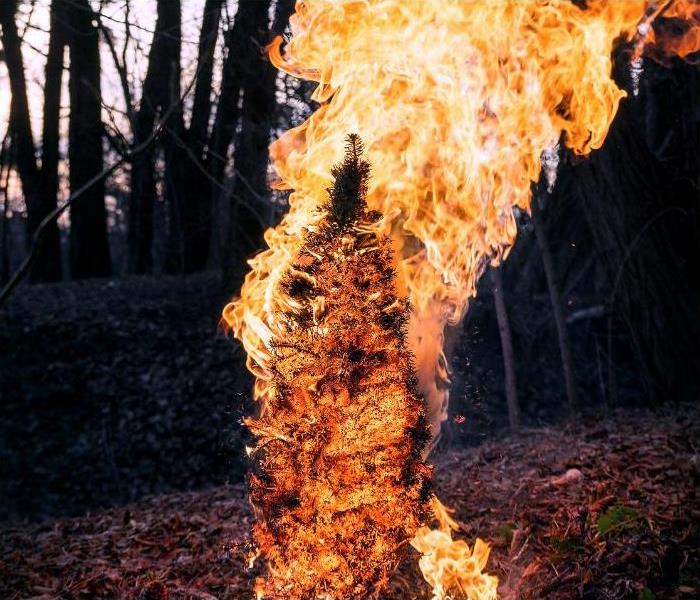 Prevent Fire Damage on your Commercial Property this Holiday Season.
Prevent Fire Damage on your Commercial Property this Holiday Season.
The holiday season is now upon us, and with upcoming family gatherings, home cooking, and festivities, fire damage can become a more serious concern.
Experiencing commercial fire damage can be devastating to the well-being of your business, not to mention your reputation in the community. Learn how to prevent that kind of damage with these five tips for protecting your commercial real estate from tenant fire damage.
Bring Awareness to the Danger of Fires During the Holiday Season
Thanksgiving is the peak day for home cooking fires, followed by Christmas Day, the day before Thanksgiving, and Christmas Eve. Cooking equipment was involved in one of every five home decoration fires according to this article by the National Fire Protection Association.
Consider sharing these statistics in an email to your commercial property tenants along with additional fire prevention tips, or upcoming fire safety checks to tenants.
Schedule Fire-Safety Checks
If your commercial real estate property has tenants, then you should schedule fire-safety checks for them at least once a year. Doing so could save your property and your tenant lots of money and inconvenience down the road.
If you have not done so yet, consider scheduling a smoke alarm test, fire extinguisher checks, and Fire Sprinkler tests before Thanksgiving. A tenant’s fire can cause substantial damage to surrounding areas, which is why it’s best if fires are prevented before they have the chance to spread.
Remind Tenants of Responsibilities & Expectations During the Holiday Season
Holiday parties are good for business, but they can also cause some problems. While it’s important to ensure your tenants are enjoying themselves, you should also make sure that your tenants know what they’re allowed and not allowed to do in terms of decorations. If you allow decorations, make sure that they’re safe; if you don’t allow them, it’s important that your staff knows that too. When left unchecked, tenant-placed holiday decor can become hazardous quickly.
Another good idea is to remind tenants to review their renter's insurance policies before the holiday season and document personal belongings. This reminder can also be a great way to improve customer service for your tenants.
Talk to Your Insurance Agent to Ensure Policy Coverage
If you own a commercial building, your insurance agent is your number one source for learning about commercial building restoration and policy coverage. Agents with experience in commercial property damage can walk you through what types of coverage you have. They can also help explain the potential scenarios in which you should consider calling a large loss restoration contractor like SERVPRO of Houston County.
With a bit of planning ahead of time, taking swift action in a crisis is a little easier!
Create Fire Action Plan
Commercial buildings are more likely than residential properties to have fires, and smoke can spread quickly through open hallways. To protect your tenants and property, consider creating an easy-to-follow document that spells out what actions everyone should take in case of fire or other disaster. You can make one with Google Docs or another online platform.
SERVPRO of Houston County provides a great, free program for our commercial property owners and managers called an Emergency Ready Profile. This could help serve as an important part of developing your fire action plan. For more information on obtaining your Emergency Ready Profile, please contact us at: 478-224-4148
Conclusion
There are many ways that you can be proactive about fire safety. However, if a fire does happen at your property, make sure you have an experienced large loss restoration company on your side. For more information or for assistance with restoring your commercial real estate after a fire, contact us at 478-224-4148 today.
Keep It Fire-Safe This Spring & Summer | SERVPRO® of Houston County
6/22/2021 (Permalink)
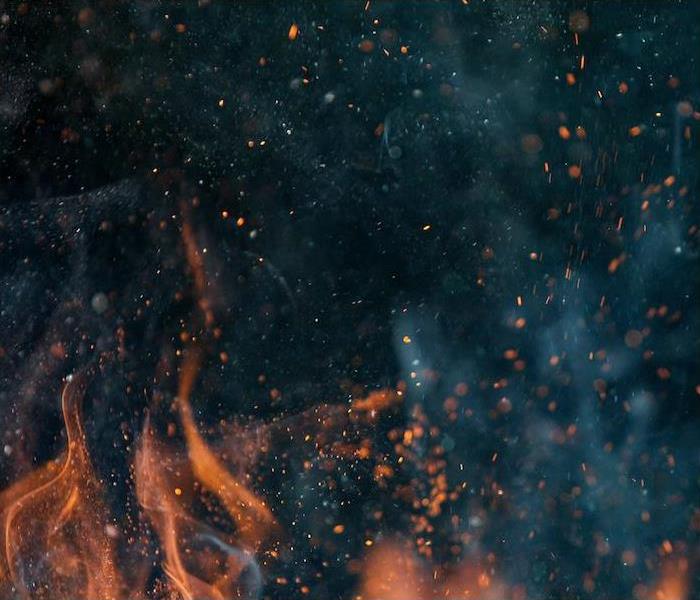 Restoring fire and smoke damage is one of our specialties. Contact SERVPRO of Houston County to learn more.
Restoring fire and smoke damage is one of our specialties. Contact SERVPRO of Houston County to learn more.
Spring is undeniably beautiful. The weather is pleasant and mild, the flowers and trees are really showing off their plumage, and nature beckons us outdoors after the long, cold winter.
There are lots of reasons for backyard gatherings as well. We love to celebrate everything from graduation day to wedding engagements, church socials and family reunions, and many of these events all but necessitate a meal cooked on the family grill.
But springtime activities in the backyard also lead to an increased fire risk. In fact, spring sees more daily fires on average than any other time of year. But with just a little effort, you can take the necessary steps to host your home activities safely.
The grill. Grills are the greatest need for care in regard to spring fire safety, as they’re the top cause of accidental fires. Anytime you combine high heat, grease, gas and flammable materials in close quarters, there’s a risk. Keep your grill in good working order, make sure it’s away from anything that might catch fire and don’t forget to clean it between uses. Almost 20% of grill fires are due to poor cleaning!
The fire pit. When you’re gathered in the backyard roasting marshmallows, make sure you have a bucket of water on hand, both to douse the fire slowly when you’re finished and to take care of any flames or ashes that might hop out of the pit. Be attentive to the fire at all times, and never leave pets or kids alone by the pit. And don’t add pine needles or leaves to a burning fire, as they easily break down to tiny embers that can be carried on the wind.
Chimneys and dryer vents. You clean your dryer lint trap every time you do laundry (you do, don’t you?), but sometimes lint can sneak past and gather in your vent pipe. While you’re thinking about fire safety, go ahead and clear that bad boy out. And you’re done with your chimney until fall, so get rid of built-up ash and soot so you’re not starting fires in a hazard when it gets cold again.
Your local SERVPRO technicians are on hand 24⁄7 for emergencies. If you encounter fire damage at your home or business, no matter the cause, we will be there faster and have it cleaned up sooner. Call or click today and experience the SERVPRO difference.
Here are Four Fire-Safe Candle Alternatives
5/11/2021 (Permalink)
Here are Four Fire-Safe Candle Alternatives
Candles are used to create decorative lighting effects or release fragrances. Whether you are looking for safer mood lighting or a way to diffuse a scent without any risk of a candle fire, here are four fire-safe candle alternatives.
1. Battery-Powered Candles
A flameless electric alternative to candles can be placed anywhere for decorative or lighting purposes. Electric candles come in a wide variety of colors, heights, thicknesses and designs. Some battery-powered models are also designed to release fragrances.
2. Strings of Lights
Another way to get a candle-lit look is to string up Christmas or fairy lights. Strings of lights are designed with fire safety in mind. Choose from strands of single-color or multicolor bulbs. It is also possible to set up lights to blink or flicker if desired. Ultra-efficient LED bulbs make replacements affordable and keep energy costs low.
3. Candle Warmers
A candle warmer may be the best option among these candle alternatives for fans of scented candles. A warmer makes it possible to enjoy these fragrances with a much lower fire risk. A warmer may be a base on which a candle sits or resemble a lamp.
4. Diffusers
Reed diffusers do not resemble candles. For a different look, reeds in oil can be an attractive, creative and flameless way to release a scent. Diffusers have an even lower risk of fire than an electric candle warmer.
Most candle fires occur around the holidays. Battery-powered candle alternatives and strings of lights are safer options for illuminated decorations. Warmers and diffusers are useful for spreading a fragrance throughout a home with a lower risk of fire. If a fire starts due to a candle or any other cause, you should attempt to extinguish the flames or contact the fire department. Fire damage restoration experts can restore or replace damaged building materials at a residence in Houston County.
Steps To Prevent A Lint Fire
5/11/2021 (Permalink)
Steps To Prevent A Lint Fire
While the kitchen is the most common room for house fires, dryer fires are another common problem. The heating of the dryer combined with lint build up can cause your dryer to burst into flames. A lint fire is scary, but there are steps that can be taken to prevent it.
Safety First
It's important to realize that even when the lint is properly cleaned from your dryer, there is still a chance of a dryer fire. For this reason, you should never run your dryer:
- When you are sleeping
- When you are not home
- When you are going to be outdoors
Leaving your dryer unattended can cause the fire to spread further, which can cause extensive damage. In addition, unplug your dryer before you start cleaning out the lint.
Vacuum Out the Lint Screen and Dryer
You probably already clean out your lint screen every time you start a new load. However, a lot of lint can get past the screen, and eventually lead to a lint fire. Take your vacuum attachment and clean underneath and around the lint screen the best you can. Refer to your owner's manual to see how to safely vacuum out the inside of your dryer.
Cleaning Out the Hose
Pull out any lint you can reach after removing the hose from the back of your dryer and the wall. If you can't reach it all, use a dryer vent snake to push it all the way through. In addition, check the pathway from the hole in the wall to the outside of your house. Use the snake to ensure that all of the lint is out of the vent.
These steps can help reduce your risk of a lint fire. You should do this at least once every six months, and more often if you do a lot of laundry. If you do experience a dryer fire, let your fire restoration experts do what needs to be done to cleanup the mess.
Holiday Fire Safety Tips to Keep in Mind | SERVPRO® of Houston County
12/2/2020 (Permalink)
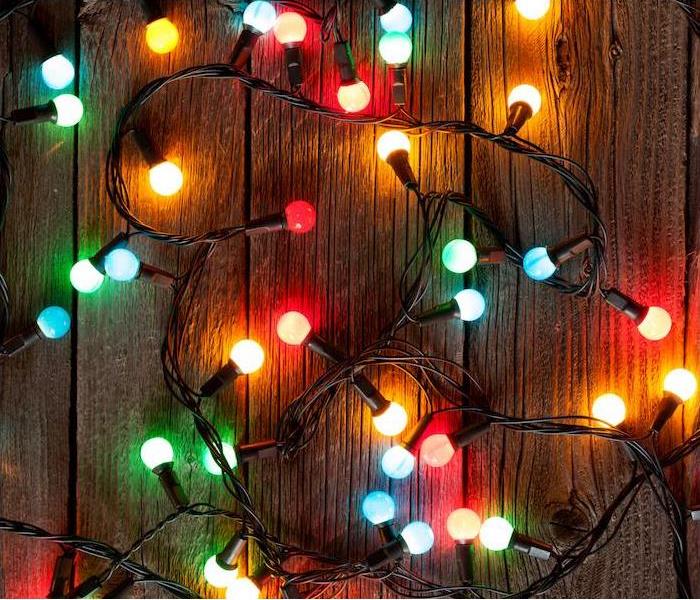 Make sure your fire risk is low during the holidays. If you experience any damage, SERVPRO of Houston County will be here to help.
Make sure your fire risk is low during the holidays. If you experience any damage, SERVPRO of Houston County will be here to help.
House fires do not discriminate based on season, but in the winter they are certainly more apt to occur. The Red Cross has reported that the winter season is the time when most house fires occur, in part because they are given more opportunity due to the fire dangers associated with winter activities.
Many people find themselves doing more in the kitchen around the holidays and in the colder months, making cooking fires more likely to occur. Additionally, more people are using heaters, fireplaces and decorations, making heating and electrical fires a possibility. Read on to discover how you can make the most of your holiday season while still practicing fire safety.
Keep Fire Safety at the Forefront of Winter Activities
Keep safe when cooking. Cooking is consistently the catalyst for the highest number of house fires during any part of the year, and winter is no different. Winter often brings about large holiday meals and extra baking projects, giving fires more of an opportunity to begin. Avoid keeping flammable objects near the stove and always be sure you have a fire extinguisher handy in case there are any incidents that occur.
Heat the house with proper precautions. Warming up areas of your home with space heaters or starting a fire in the fireplace is a great way to get cozy, as long as you keep safety in mind. Space heaters should always be equipped with sensors to prevent them from overheating or running while tipped over, and they should never be used on carpet or flammable items. For fireplaces, get your chimney inspected before you use it for the first time each year and be sure you have a grate installed properly to avoid any accidents.
Decorate with care. Adding holiday decorations is a lot of fun, but it should always be done with electrical safety in mind. Electrical and wiring issues cause around a quarter of all Christmas tree fires. Be sure none of your wires are frayed, make certain that you do not overload outlets or power strips and ensure you never leave lights or other decorations plugged in if you are away or asleep.
If you have damage due to a house fire, you can depend on us to help. Contact us 24 hours a day to report damage and receive a quick response from our certified restoration technicians. Get in touch today.
Preparing Your Business Through Regular Fire Drills | SERVPRO® of Houston County
12/2/2020 (Permalink)
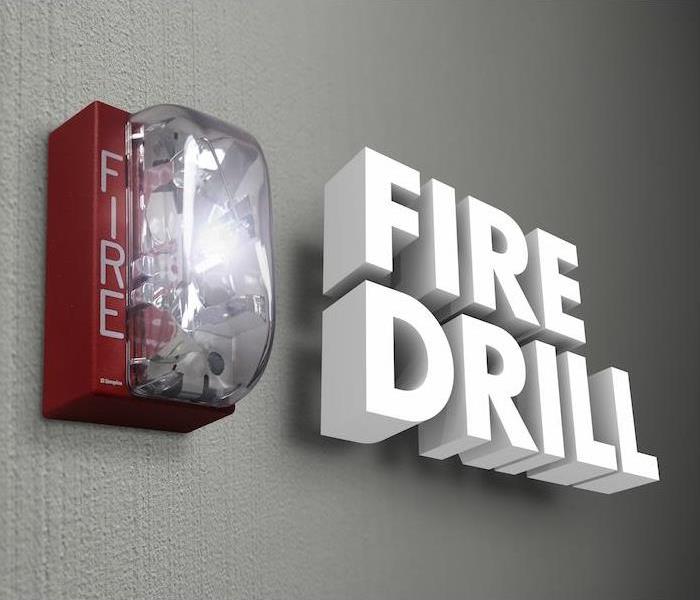 If your business experiences any fire damage, you can count on us. SERVPRO of Houston County specializes in commercial fire restoration.
If your business experiences any fire damage, you can count on us. SERVPRO of Houston County specializes in commercial fire restoration.
Owning a business involves taking on a certain level of risk, but through careful planning, these risks can be managed and mitigated. The same is true for the risks that a commercial fire poses to your business—by planning ahead, you can generally reduce its overall impact and get back to business faster.
Increasing your business’ fire safety is important and there are many aspects involved, but the most important thing to implement is a fire evacuation plan for your staff. Planning out your evacuation routes and hosting regular escape drills will keep everyone safer in what could potentially be a life-altering situation.
Keeping Staff Safe With Fire Evacuation Drills
Consult with your local fire officials. There are many places where you can research commercial fire safety, but there is perhaps no better resource than the local fire officials who service your area. Many times, they can pay you an in-person visit to evaluate your building and help you map out the best evacuation routes to pass on to your staff.
Communicate and mark fire evacuation routes. After you have determined the safest and most effective routes for escape, communicate with your staff on how to find them and what to expect from the first drill.
Have fire drills frequently. Though you do not want to have fire drills so regularly that they lose their impact, it is important that they are frequent enough to keep the safety procedures fresh in everyone’s minds. Your specific schedule should be tailored to your business needs, but many owners find that scheduling them quarterly is a great way to make it part of the routine.
Run different fire scenarios. There are many ways that a fire can start that might seem unlikely, but it is important to plan for them nonetheless. To prepare staff for every possible scenario, every fire drill should be different—create different fire starter locations and block different evacuation routes so they can adapt to changing scenarios seamlessly.
If your business has experienced fire damage, you can count on us. We specialize in commercial fire restoration and will be here for you at any hour—contact us today.
Bad Grilling Habits That Are Actually Fire Hazards | SERVPRO® of Houston County
7/14/2020 (Permalink)
There is nothing better than firing up the grill on a summer evening for a dinner cooked and eaten outdoors. While grilling is a great cooking method when the weather is nice, it presents special considerations that should absolutely be taken into account to prevent the risk of fire.
Because many of us grill often, it can become so routine that it is easy to fall into bad grilling habits, which can put you at a much higher risk for a fire. Considering there are nearly 6,000 grill-related fires a year, breaking your bad habits and being fire-safe is key.
Bad Grilling Habits That Can Lead to Fires
Getting lax about grill cleaning. Cleaning the grill is one of the more annoying tasks regarding cooking outdoors, but it is also extremely necessary both for the quality of your food and for your safety. Not only will you be able to control the heat much easier on a grill with clean grates, but you are also clearing out all the grease and crud that has accumulated, which can quickly ignite and cause a serious fire if conditions are right.
Using lighter fluid on a lit grill. While lighter fluid can be applied to cold charcoal coals in a pinch to expedite the starting process, you should always be extremely cautious when making use of it. Applying lighter fluid to a lit grill—even if the flame is extremely tiny—can quickly create a flare-up situation that can spread to you or anything nearby.
Not inspecting your grill regularly. While you probably make use of your grill on a regular basis, when was the last time you made sure that everything was working properly? If you have
a propane grill, it is important to regularly check your tank, your connectors and your lines for leaks, cracks or signs of wear. A gas leak around a lit grill can turn hazardous quickly, creating an out of control fire before you know it.
Neglecting to keep a fire extinguisher nearby. Even if you are extremely careful about grilling safety every single time you cook, accidents can still happen—and when it comes to accidents around open flames, they can be devastating. Always keep a fire extinguisher nearby when you are grilling, so if there is a flare-up, you can handle it right away and avoid further issues.
If you have fire damage to your home—regardless of the cause—we are here to help. You can get in touch with us 24/7 for a rapid response from our expert fire technicians today.
Creating a Fire Evacuation Plan That Works for Your Family | SERVPRO® of Houston County
5/28/2020 (Permalink)
Creating a fire evacuation plan is one of the best things you can do to boost your household’s
fire safety. Once flames begin to spread, you often only have one to two minutes to escape from the home, so ensuring you and everyone in your household can execute an evacuation in this
time is a great tool to keep everyone safer.
When you make a fire evacuation plan, it is important to tailor it specifically to your situation and your home’s unique features. Every household will have different considerations, which is why considering these details and scheduling regular drills of your evacuation plan is so important.
Creating a Fire Evacuation Plan Specific to Your Household
Consider any specific needs for members of your household. If everyone in your household
is able-bodied and in a middle age range, you may not have anyone that has specific needs to
consider when evacuating. However, if you have very young children, persons with disabilities,
older adults or pets, it is important that you create your plan with these household members in mind. Make sure everyone (and every pet) who may need assistance getting out of the home
has an evacuation buddy who can check on them and get them to safety.
Be sure each room has two exits.
For single-level homes, this is an easy rule to follow. However, when dealing with homes that have multiple stories, this might be more difficult to obtain. Consider storing safety ladders in each upstairs room of your home so that escapees
can utilize a window if the door is blocked by flames, and make sure every window can be
opened to the outside.
Think about the specific layout of your home.
While a fire could start anywhere, it is
important to identify areas where one is more likely to occur so you can be certain you can
evacuate regardless of the scenario. Kitchens are the most frequent place that fires occur, but
also make sure you plan for garage fires, fireplace fires or candles igniting the area around them as well. Be sure that regardless of where the fire breaks out, your rooms are set up in a way that allows you a clear path to one or more exits in the room.
If you have fire damage to your home, you can count on us to help. Get in touch with us at any
time to learn more about our fire restoration process.
Fire Safety
6/17/2019 (Permalink)
Outdoors fires are absolutely beautiful especially in the fall. The air is crisp and being outdoors is a fall favorite. When creating a fire outdoors, you definitely need to consider the environment surrounding the fire. Whether you are near your home or in a national forest, you want to ensure the fire will not burn the area. Here are some tips to keep your home and our nature areas safe.
- When selecting a fire pit location make sure you are at least fifteen feet away from tent walls, shrubs, trees, or anything that might catch fire.
- Make sure the pit area is level and clear of debris.
- Make sure the wind spot you have chosen is calm.
- Dig your pit about one foot into the ground and circle the mouth with stones.
- Always remember to check with your campsite or the U.S. Forestry Commission to see if you are allowed to have a fire at the time you plan on camping.
- Make sure that any fire you build is kept low and out of the wind. This will help keep the embers down.
Never for any reason leave a fire unattended or hot. Make sure you pour water on the fire until it stops hissing.
What to do after a fire...
6/17/2019 (Permalink)
Most full-service restoration specialists offer boarding-up services. Here are four reasons to board-up after a fire.
- You need to keep out the elements. If the structure of your property has sustained extensive damage, you should try to keep the elements out. Exposure to additional water, wind, or sunlight can compound the damage caused by smoke residue and soot.
- There is still viable stock on the premises. If products that appear viable remain in the building, you should consider boarding up. These items may require assessment and cleaning and may not be fit for sale but having them properly processed rather than stolen can be helpful for insurance purposes.
- You want to protect electronics and other valuables. Depending on the extent of the fire damage, you may be able to restore some electronics or other valuable property to working condition. Loss can be far more expensive than restoration or covered replacement.
- You want to limit soot damage. It is generally a good idea to reduce foot traffic on the scene of a recent fire. When soot gets embedded into carpeting or upholstery, it can be much more difficult to restore these materials to a pre-fire condition.
Your major concern is likely to be how to recover from fire damage as quickly and completely as possible. Preventing looting and exposure to the elements can make fire cleanup more successful. Here at SERVPRO of Houston County we will always put our customers first.
Grilling Time!
5/2/2019 (Permalink)
Spring is finally here, and it is time for grilling out with friends and family again. Grilling can become dangerous quickly. Leaving the grill unattended, improper cleaning grease or fat, placing the grill near combustible items can cause serious injuries to a person or property. Listed below are some tips on grilling safety.
- Gas-fueled grills account for 4 out of 5 grill fires.
- Choose a safe location for your grill.
- Only grill outside.
- Teach children grills can be dangerous and to be careful around a grill.
- Remember how to properly clean your grill after use.
Grilling can be a fun time to gather around and share stories over hot dogs and hamburgers. SERVPRO of Houston County assures consumers that if you fall victim to damage to your home due to a grill, we will be there to serve you.
Fire Safety
3/28/2018 (Permalink)
Outdoors fires are absolutely beautiful especially in the fall. The air is crisp and being outdoors is a fall favorite. When creating a fire outdoors, you definitely need to consider the environment surrounding the fire. Whether you are near your home or in a national forest, you want to ensure the fire will not burn the area. Here are some tips to keep your home and our nature areas safe.
- When selecting a fire pit location make sure you are at least fifteen feet away from tent walls, shrubs, trees, or anything that might catch fire.
- Make sure the pit area is level and clear of debris.
- Make sure the wind spot you have chosen is calm.
- Dig your pit about one foot into the ground and circle the mouth with stones.
- Always remember to check with your campsite or the U.S. Forestry Commission to see if you are allowed to have a fire at the time you plan on camping.
- Make sure that any fire you build is kept low and out of the wind. This will help keep the embers down.
Never for any reason leave a fire unattended or hot. Make sure you pour water on the fire until it stops hissing.
Fire Classes and how to properly extinguish them
3/28/2018 (Permalink)
Class A fires are defined as ordinary combustibles. These fires are commonly flammable material one may find around their home. These items include wood, fabric, paper, trash, and plastic. To extinguish a Class A fire use either water or monammonium phosphate.
Class B fires are defined as one that uses a flammable liquid or gas as its fuel base. These fires are a common hazard in industries dealing with fuels, lubricants, and certain types of paint. Class B fires used to be majority of kitchen fires. However, because kitchen fires are typically the most common house fire, they have their own classification. Smothering Class B fires to remove oxygen will result in extinguishing the fire.
Class C fires are defined as fires that use electrical components and/or energized equipment as its fuel source. These fires are typically fueled by motors, appliances, and electronic transformers. Electrical fires are more likely to be seen in industries that use heavy electrically-powered equipment. Bad wiring can result in electrical fires. To extinguish these fires, one should cut the power off to the source and use a non-conductive chemical to extinguish the fire.
Class D fires are defined as one that uses a combustible metal as its fuel source. These combustible metals include titanium, magnesium, aluminum, and potassium. Class D fires are typically in a laboratory environment, but they can be found in other industries. You want to completely avoid throwing water on these fires because it is ineffective and can have the opposite effect. To extinguish these fires, use a dry powder agent which will absorb the heat and smother the fire.
Class K fires are defined as a cooking fire involving combustion from liquids used in food preparation. Greases, cooking oils, vegetable fat, and animal fat are all fuel sources that Class K covers. These fires are extremely dangerous and extremely destructive. To extinguish these types of fires, wet chemical fire extinguishers should be used.
If you or someone you know falls victim to a house or business fire, call SERVPRO of Houston County at (478) 224-4148.
Grilling Safety
3/23/2018 (Permalink)
Spring is finally here, and it is time for grilling out with friends and family again. Grilling can become dangerous quickly. Leaving the grill unattended, improper cleaning grease or fat, placing the grill near combustible items can cause serious injuries to a person or property. Listed below are some tips on grilling safety.
- Gas-fueled grills account for 4 out of 5 grill fires.
- Choose a safe location for your grill.
- Only grill outside.
- Teach children grills can be dangerous and to be careful around a grill.
- Remember how to properly clean your grill after use.
Grilling can be a fun time to gather around and share stories over hot dogs and hamburgers. SERVPRO of Houston County assures consumers that if you fall victim to damage to your home due to a grill, we will be there to serve you.
Fire Safety
3/7/2018 (Permalink)
Follow these simple tips to help you and those you love stay fire safe this summer season!
- Attend public fireworks displays and leave the lighting to the professionals.
- Enjoy outdoor celebrations and cookouts but remember to keep a 3-foot “safe zone” around grills and campfires.
- Build campfires at least 15 feet away from tent walls, shrubs or other materials that burn.
If you have an emergency, SERVPRO of Houston County is available 24 hours, 7 days a week, 365 days throughout the year. We understand your emergency cannot always fall between business hours which is why we are here to serve you better. We help with smoke or fire damage to your personal belongings, home, or business. We will make it look “like it never even happened.”
Fire Damage? We can help with that!
3/6/2018 (Permalink)
Fire damage, no matter the size, can affect every square inch of your property. It can travel through air ducts, burn through ceilings and floors, and damage countless pieces of equipment and documents.
SERVPRO of Houston County has access to thousands of pieces of equipment and hundreds of personnel to help mitigate even the largest fire damage. Our experienced and technicians utilize industry knowledge, training, experience, high-tech equipment, and proprietary cleaning products to perform emergency services to meet our customer’s cleaning and restoration needs.
Performed immediately following a loss in order to reduce property and content damage, our emergency services reduce claims’ expense, and minimize customer disruption.
While the types of emergency services we provide vary, our emergency response includes:
- Boarding up the structure and securing the property to help prevent intrusions.
- Drying the structure. Water is often used to extinguish a fire, so excess water or moisture must be monitored and removed.
- Deodorization of the affected areas.
- Pre-testing and initial cleaning. Initial cleaning may help prevent additional damage caused by soot residue, and pre-testing allows the technician todetermine what can be restored to help eliminate needless and costly expenses.
- Conducting building inspections to evaluate the loss site for any safety or health hazards.
Call SERVPRO of Houston County at (478) 224-4148 for all your Fire Restoration needs!
Every Second Counts When It Comes To Restoring Your Property
1/22/2018 (Permalink)
Every Second Counts When It Comes To Restoring Your Property
Fire damage, no matter the size, can affect every square inch of your property. It can travel through air ducts, burn through ceilings and floors, and damage countless pieces of equipment and documents.
SERVPRO of Houston County has access to thousands of pieces of equipment and hundreds of personnel to help mitigate even the largest fire damage. Our experienced technicians utilize industry knowledge, training, experience, high-tech equipment, and proprietary cleaning products to perform emergency services to meet our customer’s cleaning and restoration needs.
Performed immediately following a loss in order to reduce property and content damage, our emergency services reduce claims’ expense, and minimize customer disruption.
While the types of emergency services we provide vary, our emergency response includes:
- Boarding up the structure and securing the property to help prevent intrusions.
- Drying the structure. Water is often used to extinguish a fire, so excess water or moisture must be monitored and removed.
- Deodorization of the affected areas.
- Pre-testing and initial cleaning. Initial cleaning may help prevent additional damage caused by soot residue, and pre-testing allows the technician to determine what can be restored to help eliminate needless and costly expenses.
- Conducting building inspections to evaluate the loss site for any safety or health hazards.
Call SERVPRO of Houston County for all your Fire Restoration needs!
 Fire safety is a top priority for us at SERVPRO of Houston County this winter. Keep your home safe with these helpful tips!
Fire safety is a top priority for us at SERVPRO of Houston County this winter. Keep your home safe with these helpful tips!



 24/7 Emergency Service
24/7 Emergency Service









